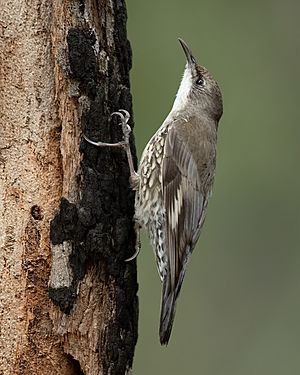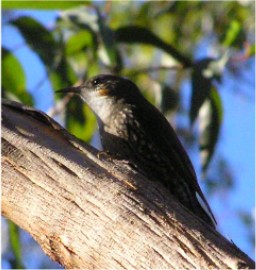White-throated treecreeper facts for kids
Quick facts for kids White-throated treecreeper |
|
|---|---|
 |
|
| C. l. leucophaea | |
 |
|
| C. l. minor | |
| Conservation status | |
| Scientific classification | |
| Genus: |
Cormobates
|
| Species: |
leucophaea
|
| Synonyms | |
|
Climacteris leucophaeus |
|
The white-throated treecreeper (Cormobates leucophaea) is a small bird that lives in the forests of eastern Australia. It's not related to the treecreepers found in other parts of the world. This bird is about 15 cm (6 in) long. It has mostly brown and white feathers. The white-throated treecreeper mainly eats insects, especially ants. Unlike some other treecreepers, it doesn't share its parenting duties with other birds. It also looks for food on different types of tree bark.
Contents
About the White-throated Treecreeper's Name
The white-throated treecreeper was first described in 1801 by a bird expert named John Latham. He first called it Certhia leucophaea. For many years, it was placed in a different group of birds called Climacteris.
The name of its group, Cormobates, comes from ancient Greek words. Kormos means 'trunk of a tree', and batēs means 'to go' or 'to travel'. This name describes how the bird moves up and down tree trunks. The second part of its name, leucophaea, also comes from ancient Greek. Leuko- means 'white' and phaios means 'dun' or 'dusky'. This refers to the bird's feather colors.
Some books might show its name as Cormobates leucophaeus. However, experts decided in 2001 that the group name Cormobates is feminine. So, leucophaea is the correct way to write the species name.
The Papuan treecreeper (Cormobates placens) used to be thought of as a type of white-throated treecreeper. But now, it's known as its own separate species.
Different Types of White-throated Treecreepers
There are five known types, or subspecies, of the white-throated treecreeper:
- C. l. leucophaea: This is the main type. It lives in southeastern Australia, including parts of South Australia, Victoria, and New South Wales.
- C. l. grisescens: This type is found in the Mount Lofty Ranges in South Australia.
- C. l. intermedius: This type was described in 1983. It lives only in the Clark and Connors Ranges in Central Queensland.
- C. l. metastasis: This type was described in 1989. It is found in southeastern Queensland and northeastern New South Wales.
- C. l. minor: This type lives in northern Queensland. It was first described in 1891 after being found near Cairns.
What the White-throated Treecreeper Looks Like
This bird is usually between 13 and 17 cm (5–7 in) long. Its wings can spread out about 19 to 26 cm (7.5–10 in), with an average of 23 cm (9 in). It weighs about 22 g (0.8 oz).
The white-throated treecreeper has a white throat and chest. Its belly and sides have dark brown and white stripes. The top part of its body and its wings are a dark grayish-brown. You can also see a buff-colored patch on its wings. Unlike some other treecreepers, it doesn't have a light-colored stripe above its eye. Its beak and feet are black.
Female white-throated treecreepers have a pale orange-brown patch on their cheek. Young birds have an orange-brown rump and white marks on their shoulders. The bird's call is a sharp, peeping sound.
Where the White-throated Treecreeper Lives
The white-throated treecreeper can be found in many parts of eastern Australia. Its range stretches from the Gulf St Vincent in South Australia, through Victoria, and into eastern New South Wales and southeastern Queensland. There is also a group further north, from Mount Spec to Cooktown. These birds prefer to live in wet sclerophyll forests and rainforests.
In Australia, this bird is protected by the National Parks and Wildlife Act of 1974.
What the White-throated Treecreeper Eats
The white-throated treecreeper mainly eats insects, especially ants. However, it will also sometimes eat nectar from flowers. A study in 2007 in the Australian Capital Territory showed that these birds liked to look for food on rough-barked eucalyptus trees. They preferred the red stringybark tree over smooth-barked trees.
The birds would pick up insects from the bark while perched. They would also look closely and even drill into dead wood to find insects. One female bird was seen eating a type of fungus called white punk.
Reproduction and Life Cycle
Unlike some other treecreepers, the white-throated treecreeper does not share its parenting duties with other birds. They usually have one group of babies each year, between August and December.
The nest is shaped like a cup and is built inside a hollow in a tree. It's made from fur, hair, feathers, and moss. The nest is usually about 4 to 5 m (13–16 ft) above the ground. The female bird lays two or three creamy-white, oval-shaped eggs. These eggs have a few dark purple or reddish-brown spots and are about 23 x 18 mm in size.
See also
 In Spanish: Corretroncos gorjiblanco para niños
In Spanish: Corretroncos gorjiblanco para niños



